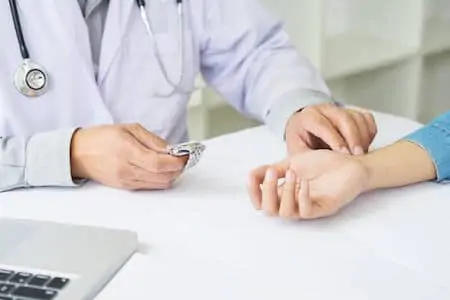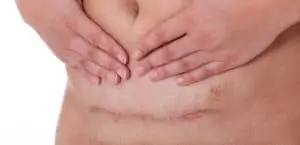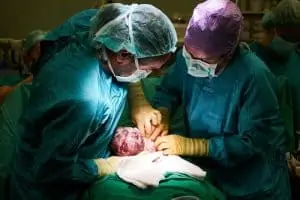In most cases, c-section recovery is straightforward, and you start to feel better soon after. You might also face complications, such as your incision opening after your surgery. Many women experience their c-section incision opening; you need to know the signs.
I always worried about my c-section incision opening. It was one thing I did not want to happen, so I had to know if certain activities increased the risk and the signs needed. My doctor told me I needed to avoid exercising, lifting, and other activities and be sure to support my recovery.
If you feel the same concern or think your incision has opened, here is what you need to know.
Understanding Dehiscence After Your Surgery
When your incision opens, it’s called dehiscence, which can range in severity. You might have a loose suture or a small area that starts to pull apart. Other times, dehiscence is a severe issue when the entire incision opens, allowing you to see the tissue underneath.
That can be quite scary, as you might imagine! 😮
Risk Factors for Wound Dehiscence
Some factors increase the risk of dehiscence, and these factors apply to all surgeries, not just c-sections.
- Diabetes
- Liver, kidney, and heart disease
- Obesity
- Smoking
- Steroids
- A weak immune system
The Reasons for a C-Section Incision Opening
Stress on your incision is the main reason your c-section incision would open, but there are several ways that stress or pressure is applied to your wound.
Exercise
Most OBGYNs don’t clear you for exercising until you’re 6-8 weeks postpartum, and there is a good reason for that. Your incision is still healing, and it is too risky. Exercising could lead to wound opening.
Falling
Accidents happen, and if you trip and fall, it could cause your incision to open. That also applies to if you were in a car accident or something else. Any accident could put stress on your wound.
Lifting

Do you remember when your doctor told you to avoid lifting anything heavier than your baby for several weeks? That advice was for a good reason. Even precautions should be taken to lift a toddler within the first few weeks.
When you lift heavy objects, you put too much pressure and stress on your incision and sutures. That pressure could cause your stitching to pop open, potentially allowing your entire incision to open. Learn more about how to take care of those stitches after a c-section.
Infections
Any infection could disrupt your incision and lead to the opening of the wound. Knowing the signs of infection is essential so you can call your OBGYN. If an infection is left there, it could cause many problems.
Here are a few signs of infection.
- Fever of 100.4℉ or higher
- Weird smell from the wound
- Pus coming out of the wound
- Redness around the wound
- Swelling
- Hot to the touch
Not Bracing Your Incision
It’s not common, but sometimes, failing to brace your incision could put too much pressure. Typically, this would lead to just a popped suture, not your entire incision opening. It would be best if you braced when coughing or sneezing, and you might find it helpful to do so when you have a bowel movement.
In addition, if you find a hole or two in your c-section incision area, call your doctor.
How to Prevent Your Incision from a C-Section Opening?
It’s not always possible to prevent a superficial or complete c-section opening, but some things help reduce the risk. Taking every precaution possible while you heal and recover increases the chances of a successful recovery.
1. Avoid Exercise
Exercising must be avoided until you are cleared by your doctor between six and eight weeks postpartum. Most doctors approve exercise eight weeks after your surgery. A c-section incision can open six weeks after surgery if it’s not healed properly.
Exercising before your doctor clears you will increase the chances of your c-section incision opening. It puts unnecessary pressure on your incision, which might cause stitches to pop open.
If you feel you must exercise to support your mental help, try slow walks around the neighborhood. Lifting, running, and stretching pull on the incision too much.
2. Avoid Too Much Physical Activity
I understand that taking it easy is boring, and when you’re used to being on the go all the time, it’s difficult to avoid physical activity. I went to Wal-Mart four days after my c-section and paid for it with pain and heavy bleeding. However, I could have opened my incision.
Gradually increase your physical activity each day, but if you think you can go for a hike when you’re two weeks postpartum, you aren’t thinking gradually enough. Many women who have experienced a c-section incision split open were due to overexerting themselves.
Chores and housework must wait or be completed on a delayed schedule. Support your body for the following weeks to allow for proper healing.
3. Rest As Much As Possible

Since physical activity is off the table, you need to rest. When you rest, your body gets to work healing. It devotes energy to healing and mending your incision, exactly what you want.
Rest as much and as often as possible. If your body feels sore, it’s time to rest. If you washed a few dishes, rest afterward. It’s impossible to relax too much at this time.
4. Do Not Lift
Similar to exercise, lifting puts unnecessary strain on your incision. Many women who lifted too much experienced their c-section incision opening little or small areas. Any pressure or strain could cause dehiscence.
5. Don’t Scrub the Area
Rubbing or pressing on the incision area in the early weeks might cause a superficial c-section opening. That means the exterior rather than the inside might open a little. This is considered less severe than the internal incision opening, but it leaves room for bacteria to enter and cause an infection.
6. Avoid Sexual Intercourse
The earliest you can have sexual intercourse is six weeks postpartum. Some women think having a c-section allows them to have sex sooner, but no matter if you have a vaginal birth or a cesarean section, you have a wound inside your uterus where your placenta detached. Having sexual intercourse too soon might cause your cs-section incision to split or a uterine infection to develop.
7. Take Stool Softeners or a Laxative
Take stool softeners daily if you strain when passing a bowel movement. A laxative might be needed when you are constipated to reduce the risk of opening your c-section incision.
How Do I Know If My C-Section Opened Inside?
You need to pay attention to your incision after your surgery. If you wonder – how do I know my incision is opening? Inspect it daily for any signs of infection, and it’s healing correctly. If you notice any problems, you can address the issue with your doctor immediately.
During your inspection, if you see that a suture is loose or your Steri Strips fell off, it’s not an issue that requires a call to your doctor.
Some other signs that your incision is opening or problems are occurring include:
- Redness or swelling around the incision
- A sudden fever higher than 100.4℉
- Oozing and drainage from your incision
- Pain or tenderness ins a specific area
- A foul smell from the incision
- Feeling that the wound is giving away
- Leaking pink or yellow fluid from the wound
When Should I Go to the Doctor?
As I mentioned, loose sutures or Steri Strips that fell off aren’t an issue, but if your incision starts to gape open, you need to call your doctor. Notifying your doctor of an incision opening is essential because it allows bacteria and materials to enter your wound. That increases the risk of infection, or it might let your wound open further.
If a small part of your incision opens, use a clean bandaid to cover it and let your doctor know. If it opens wide, then cover it and call your doctor. You’ll need to go to the emergency room.
What Happens If My Incision Opens
You first need to call your doctor, who will let you know if you need to come into the office to be seen.

Once there, your doctor will examine the opening. Small openings typically won’t require any medical procedures. Your doctor might use a Steri Strip to close it again once cleaning the area. He will advise you to close the incision and monitor for signs of infection, which you did before.
In some cases, a wound vacuum will be placed over your wound. The purpose of a wound vacuum is to remove fluid or infection from the incision site, letting it heal and close. Other times, doctors need to pack your wounds with bandages to allow them to heal appropriately.
Your doctor might use a belly binder to help decrease any pressure or stress applied to your wound. Binders hold your incision together.
An open wound is rarely life-threatening, but those cases are called evisceration when the incision opens wide and internal organs protrude from the body.
Remember, this is scary, but it is not common.
In the case of evisceration, your doctor will need to perform surgery to stabilize and close your incision. Be sure to call 911 if this happens. It would be best if you did not drive yourself to the hospital. Lay down and elevate your legs until help arrives!
My C-Section Incision is Opening – How to Clean It
If your c-section incision opens, your doctor may send you home with specific instructions to keep the area clean and dry.
The first thing you should do is cover the opening with a clean bandage and tape over it to keep it secure. If only a small spot is open, it’s not an emergency, but your doctor will want to check the opening and determine whether you need antibiotics or additional steri strips.
After coming home from the doctor, here’s what you should do to clean your opening wound.
- Let soap run over it every day when taking a shower.
- Never cover it with a bandage until it’s entirely dry. Consider using a hairdryer on low and keeping away from the incision to ensure it dries properly.
- Keep gauze over the top until it closes again to prevent bacteria from entering the wound.
- Give your incision time to air dry each day after it starts to heal. This might be laying on your bed for 10-15 minutes with your incision out in the air, helping it heal.
Is a C-Section Scar Opening Up Years Later Possible?
Perhaps you’ve seen stories online where women say their incisions opened up several years after surgery.
Can that really happen?
It’s possible but highly unlikely. Most c-section scars heal well after one year, so the possibility of its opening is low. The more c-sections you’ve had, the higher your chance of a c-section scar opening years later. That’s because the scar is weakened, along with the uterine walls around it.
Call your doctor immediately if this happens to you, even if a small area opens. You don’t want an infection!
Final Thoughts
You must watch for signs that you need immediate care, such as blood soaking through your bandage or tissue coming through your wound. Those are times when you need to head to the nearest emergency room. Make sure you avoid situations that lead to your c-section incision opening and rest often to give yourself time to heal.
Hey, this is Linda. My biggest accomplishment in life is being a mother of four children. Their current ages range from almost ten years old down to 20 months old.
I’m passionate about writing parenting articles because I understand so well all of the problems and trials you face as a parent. From breastfeeding woes to budgeting problems and behavior problems, along with everything in between, chances are I’ve faced it over the last ten years. Read more about Linda here.






